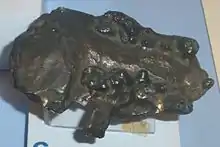Enhydriodon
Enhydriodon was a genus of otters that lived in what is now Ethiopia during the Miocene and Pliocene epoch. The otter is thought to be a relative of modern-day otters. Enhydriodon was described as a considerably large otter, though only its skull has been found. Estimates put it at about 200 kilograms (440 lb), making it the largest mustelid described so far.[1]
| Enhydriodon | |
|---|---|
 | |
| Scientific classification | |
| Kingdom: | Animalia |
| Phylum: | Chordata |
| Class: | Mammalia |
| Order: | Carnivora |
| Family: | Mustelidae |
| Tribe: | †Enhydriodontini |
| Genus: | †Enhydriodon Falconer, 1868 |
| Type species | |
| Enhydriodon sivalensis Falconer, 1868 | |
| Other species | |
| |
References
- "Enhydriodon dikikae, sp. nov. (Carnivora: Mammalia), a gigantic otter from the Pliocene of Dikika, Lower Awash, Ethiopia". Journal of Vertebrate Paleontology. 31: 447–453. doi:10.1080/02724634.2011.550356.
This article is issued from Wikipedia. The text is licensed under Creative Commons - Attribution - Sharealike. Additional terms may apply for the media files.